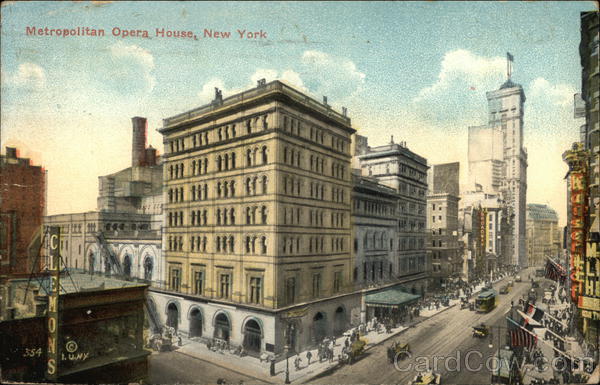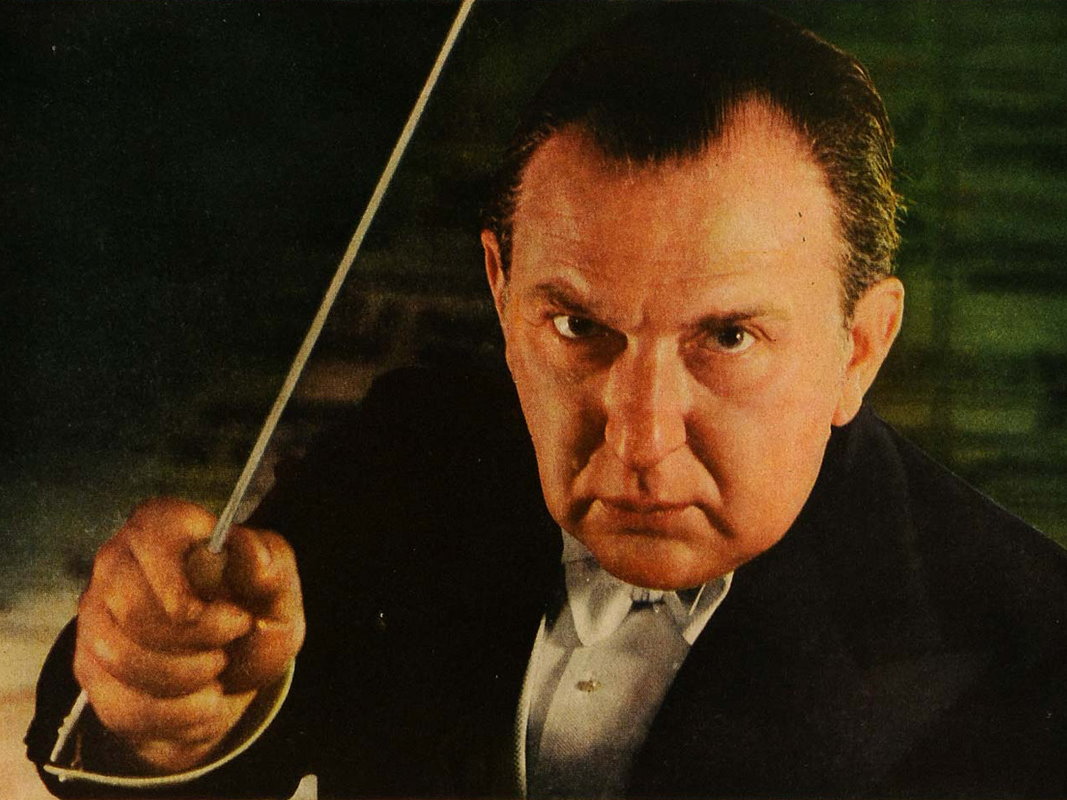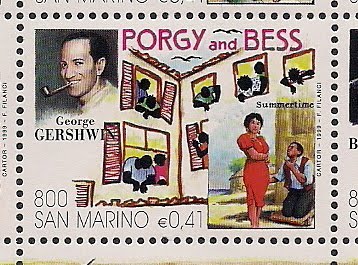"He who joyfully marches to music in rank and
file has already earned my contempt. He has
been given a large brain by mistake, since for
him the spinal cord would fully suffice."
AUTHOR: Albert Einstein
COMPOSER
GERSHWIN
PORGY AND BESS
(Concert Version)
Simon Rattle, Conductor
Berliner Philharmoniker
Cape Town Opera Voice of the Nation Chorus
INFORMATION MOSTLY FROM:
Program Notes by J. Michael Allsen
The score for Porgy and Bess was completed in
September of 1935. The premiere took place in Boston,
on September 30, 1935. The "concert version" heard was
prepared in 1956 by Robert Russel Bennett, and was first
performed in New Haven, CT, on June 26, 1956.
The beginnings of Porgy and Bess date
to 1926, when Gershwin read
DuBose Heyward's
| DuBose Heyward |
Porgy,
| http://www.courttheatre.org/images/ article_images/porgy_dustjacket.jpg |
a novel inspired by characters and
The title character was based directly
on Goat Sammy, a crippled black man
who got around on a goat-drawn cart.
This character was inspired by a real
person named Samuel Smalls or as
| https://bullrunnings.wordpress.com/ category/the-american-civil-war/page/4/ |
some called him, "Goat Cart Sam."
Smalls was born in 1889. By the 1920's,
he and his goat cart were familiar figures
on downtown streets. He was also well-
known to the constabulary. Heyward
apparently learned of him through a
News & Courier article
| http://blog.genealogybank.com/more-back-issues-of-the-charleston-news-and-courier-now-online.html |
recounting Smalls' arrest
after he’d tried to shoot a woman. The
police only apprehended him after he and
his goat led them on a chase down several
alleys. He’d been arrested a year earlier
on a similar charge.
The setting for the novel, Catfish Row,
| Catfish Row by George Biddle |
was a fictionalized version of Cabbage Row,
a cluster of shabby tenements in Charleston.
|
Low income tenement inspired DuBose
Heyward novel Porgy in 1925 |
 |
| Alson Clark: Old Houses, Charleston |
.jpg) |
| Cabbage Row in Modern Times |
Gershwin, who had already tried to
create an opera with black characters
in his unsuccessful Blue Monday
(A One-Act Jazz Opera, included in
BLUE MONDAY
Concert Version
Part 2
BLUE MONDAY
quickly wrote to Heyward proposing a
collaboration. Heyward was politely
interested, but it would be nearly six
years before Gershwin would return
to the work. In the meantime, in 1927,
Heyward and his wife Dorothy
| Dorothy and DuBose Heyward |
produced a successful stage version
of Porgy that ran for some 369
performances in New York. Their play
included several spirituals and other
musical material, but Gershwin had
something much more
elaborate in mind.
Gershwin and Heyward renewed their
correspondence in 1932, but work did
not begin until the end of 1933. Heyward
was uncomfortable in New York, and
Gershwin was unable to leave, so much
of their collaboration was carried on
by mail and telegram.
 |
| An Example of a Telegram |
Eventually Ira Gershwin was brought
into the project. Ira was responsible for
the majority of the song lyrics, though
Heyward was solely responsible for one
of the show's finest songs, Summertime.
Eventually, George did make a trip to
Charleston in the summer of 1934 to try
to get the local flavor right and to hear
the Gullah dialect that is so much a part
of Heyward's novel and libretto.


 |
| An example of Gullah art |


Gershwin and the Heywards spent
the summer together on Folly Island,
on one of the Barrier Islands
outside Charleston
| A photo of George Gershwin and his cousin, artist Henry Botkin on Folly Beach, 1934 |
He had to return to New York in the fall
because of his contract with Feen-A-Mint,
 |
| http://knowotr.blogspot.com/2008/07/and-now-word-from-our-sponsor.html |
SPONSORED BY FEEN-A-MINT
He introduces and plays his
Concerto in F Movement 3
https://www.youtube.com/watch?v=e-VjyGArkHM





but their long-distance collaboration
continued, and Gershwin began to
create a score for Heyward's libretto.
By the end of 1934, Gershwin was looking
for a producer and beginning to cast the
production. Both Gershwin and Heyward
agreed that Porgy and Bess was to be a
serious work, produced with an all-black
cast, dealing in a sympathetic and realistic
way with its characters. At the time, African
American singers were excluded from the
operatic stage: Marian Anderson,
possibly the finest soprano of the day,
had not appeared on the stage of the
Metropolitan Opera.
 |
| https://www.cardcow.com/455296/metropolitan-opera-house-new-york/ |
African American characters were also
largely absent from Broadway, and when
they were there, it was still routine for
these characters to be played in blackface,
| Al Jolson as himself and in "blackface." |
the ugly legacy of the old minstrel show
tradition. Broadway star Al Jolson, who
made Gershwin a star years earlier
singing Swanee in blackface, at one
point tried to leverage Heyward's
.jpg) |
| https://sfopera.com/SanFranciscoOpera/media/ SiteAssets/Guild/Porgyand-BessStudyGuide.pdf |
Porgy as a star vehicle for himself.
All-black shows like In Dahomey
and Shuffle Along
had occasionally made it on to Broadway,
but these were far from the mainstream.
Kern and Hammerstein's
 |
| Left: Oscar Hammerstein, Lyricist Right: Jerome Kern, Composer |
Show Boat of 1927

was one of the only hit musicals
to feature an integrated cast.


In the original production Porgy
and Bess rehearsals went well,
PORGY AND BESS
1935 SILENT HOME MOVIE
The original cast of Porgy and
Bess
Todd Duncan, Anne Brown,
John W. Bubbles,
and Rouben Mamoulian
(the director)
| Rouben Mamoulian |
as well as myriad other cast members, can be seen
here
rehearsing the show. Anne sits on the stoop
and clearly sings "Porgy,
I's Your Woman Now," and
Bubbles seems to be performing "There's A Boat
That's Leaving Soon for New York."
though there were some troubles with
John W. Bubbles, the vaudeville dancer,
often known by followers as just plain
"Bubbles," specifically chosen by
Gershwin for the role of the crooked
Sportin' Life. According to Gershwin,
"Many people questioned my choice of
a vaudeville performer
for an operatic role
but on opening night they
cheered Bubbles."
(John William Sublett 1902–1986)
The "Father of Rhythm Tap," Bubbles was the first
tapper to drop his heels, adding complex rhythms
and syncopations to his routines by creating off-beats,
altering accents, phrasing, and timing while
simultaneously projecting an easy nonchalance. He
was also George Gershwin's personal choice to play
"Sportin' Life" in Porgy and Bess.

THE MAKING OF PORGY AND BESS
The Original Live Play, 1935

According to the usual practice for
musicals, Porgy and Bess was given
a tryout performance in Boston before
settling in on Broadway, though the
cast did give an un-staged run-through
at Carnegie Hall
first. Reaction to these preliminary
performances was everything they could
have hoped for. One Boston reviewer
wrote that Gershwin:
"…has traveled a long way from Tin Pan Alley.
| Tin Pan Alley and Gershwin |
He must now be accepted as a serious composer."


There had been some rumors of a place for
Porgy and Bess at the Metropolitan Opera,
but when it was produced in New York it was
on Broadway,
 |
| Broadway |
at the Alvin Theater,
| Alvin Theatre |
where it opened on October 10.
| Porgy and Bess Curtain Call at Alvin Theatre, 1935 |
enthusiastic as the Boston audience
had been, but the reviews ran from
lukewarm to savage: the "Kiss of Death"
for a Broadway production. Porgy and
Bess closed after a respectable, but
hardly profitable run of 124 performances.
Though several of the individual songs
quickly became well-known, Gershwin
did not live long enough to see his proud-
est creation universally acclaimed as one
of the masterworks of American music.
Gershwin seems to have been a bit
uncomfortable about Porgy and Bess's
"operatic" nature: he described it as
"folk opera." Several critics charged that
Gershwin had simply created a somewhat
dressed-up and pretentious Broadway
show, grouped around a series of popular-
style songs. Gershwin answered by stating:
"It is true that I have written songs [as
opposed to arias] for Porgy and Bess. I am
not ashamed of writing songs at any time so
long as they are good songs."
His use of recitative and his sophisticated
use of the orchestra were certainly closer
to the operatic world than anything else on
Broadway at the time. Like Bernstein's West
Side Story some twenty years later, Porgy
and Bess is a masterful blend of both traditions.
The most often-heard orchestral versions
of
Porgy's music were
prepared after
Gershwin's death by his longtime
collaborator and great Broadway/Hollywood
orchestrator, Robert Russell
Bennett
who, by 1956, had prepared the standard
concert version, "Porgy and
Bess: A
Symphonic Picture" (1943) where he leaves
Symphonic Picture" (1943) where he leaves
Gershwin's score largely intact, bringing
together the most popular moments of Porgy
and Bess with a few connective
passages and edits.
PORGY AND BESS:
A SYMPHONIC PICTURE
Arranged by Robert Russell Bennett
(Gershwin's good friend and sometimes assistant)
Fritz Reiner, Conductor
Pittsburgh Symphony, 1945
that were used in this arrangement
are as follows:
Scene in Catfish Row (with peddlers' calls)
Opening of Act 3 (3:23)
Opening of Act 1 (6:05)
"Summertime" (6:32)
"I Got Plenty o' Nuttin'" (9:08)
Storm Music (10:31)
"Bess, You Is My Woman Now" (12:03)
The Picnic Party (15:52)
"There's A Boat That's Leavin' Soon For New York" (17:55)
"It Ain't Necessarily So" (20:40)
Finale ("O Lawd, I'm On My Way") (22:24)
 |
| Conductor Fritz Reiner |
This is the only recording that Fritz Reiner made
of this well-known arrangement by Robert Russell
Bennett, which was prepared in 1942 at Reiner's
instigation. Bennett writes, in a quote extracted
from the liner notes for this album, that
"Dr. Reiner selected the portions of the opera that
he wanted to play and also set the sequence of the
excerpts. He expressed his ideas as to instrumentation,
wishing to make generous use of saxophones and
banjo, and to dispense with Gershwin's preferred
instrument, the piano."
"I proceeded not only to follow Dr. Reiner's ideas
faithfully, but also to remain completely loyal to
George's harmonic and orchestral intentions.
In other words, although carrying out Dr. Reiner's approach, I
have been careful to do what I knew - after many
years of association with Gershwin - Gershwin would
like as a symphonic version of his music."
Bennett later created another version called
"Porgy and
Bess: Selections for
Orchestra" in 1962.
Gershwin himself prepared a
"Suite from Porgy and Bess" in 1935
(later
retitled Catfish Row by
Ira,
probably to avoid
confusion with
Bennett's "Symphonic
Picture"). It
was
premiered in
Philadelphia in January
1936, and prior to his death in 1937,
there were nearly
40 performances of
the piece, most of them conducted by
Gershwin himself.
It
was rarely performed for two decades
after
the composer's death, but in 1958,
it was "found" in Ira
Gershwin's library,
and eventually gained a place in the
repertoire next to
Bennet's versions.
PORGY AND BESS SUITE
Kurt Masur, Conductor
Catfish
Row is a fairly straightforward
series of excerpts directly from the
score organized into five
movements,
with
vocal lines given to various
instruments in the orchestra. The
opening
movement, "Catfish Row,"
includes the
overture and first scene,
with part of the "Jasbo Brown Blues"
for solo piano,
and the song
"Summertime," sung first by solo
violin, then by
oboe, and
concluding
with a brief, newly-composed tag.
Porgy Sings
includes Porgy's
two big
moments from Act II, first "I Got Plenty
O' Nuttin'"
recast as a jaunty
banjo solo,
and then the passionate "Bess You Is
My Woman Now"
played by
strings.
The
furious music of the "Fugue"
first
appeared in Act I, as Crown
and
Robbins fight, but later accompanies
the climactic fight
between Porgy and
Crown in Act III. The
music of
"Hurricane"
comes from the end of Act II,
with a lyrical English horn solo and a
sense of increasing
tension giving way
to the ferocious music of the storm.
%2C%2Bby%2BJoseph%2BDelaney%2B(1904-1991)%2C%2Bis%2Bpaired%2Bwith%2Btwo%2Bpieces%2Bof%2Bmusic.%2BWhich%2Bdo%2Byou%2Bprefer%2C%2B%E2%80%9CHurricane%2C%E2%80%9D%2Bfrom%2BGeorge%2BGershwin%E2%80%99s%2B(1898-1937)%2BCatfish%2BRow%2BSuite%2B(1936).jpg) |
| Joseph Delaney: City Life (1938) This art is sometimes paired with "Hurricane" from Gershwin's Catfish Row Suite |
The
conclusion, "Good
Mornin' Sistuh,"
is
the opera's conclusion as well,
with versions of "Good Mornin'
Sistuh,"
"Sure
to Go to Heaven," and Porgy's
concluding song with chorus,
"Oh
Lawd I'm On My
Way."
THE SIGNIFICANCE OF
PORGY AND BESS
MAIN CHARACTER ROLES
SUMMERTIME
Anne Brown and Todd Duncan, Vocalists
SUMMERTIME
Louis Armstrong and Ella Fitzgerald, Vocalists
shooting craps, and he takes
the baby and sings his own
sarcastic lullaby, A woman is
a sometime thing. Tempers flare
at the game, and a fight between
Crown and Robbins ends in
Robbins's death. Crown and his
girlfriend Bess go into hiding. The
only person on Catfish Row who
will take Bess in is Porgy, who
secretly loves her. The next scene
is in the home of Serena, Robbins's
widow, where mourners are paying
their respects (Gone, gone, gone).
GONE, GONE, GONE
Sir Simon Rattle, Conductor
London Philharmonic Orchestra
There is a conflict between Serena
and Bess, who shows up with Porgy.
When Porgy urges everyone to help
the widow, the mourners sing
Overflow, overflow,
OVERFLOW, OVERFLOW
trying to drum up more money for the
collection plate. After a detective arrives
to investigate the murder, Serena sings
a heartfelt lament about her husband's
death, My man’s gone now.
MY MAN'S GONE NOW
http://accordeonduriche.canalblog.com/archives/2012/12/16/25723331.html
The act closes as Bess leads the
community in a spiritual,
The Promise' Land.
LEAVING FOR THE PROMISE LAND
Cynthia Haymon, Vocalist
Sir Simon Rattle, Conductor
London Philharmonic Orchestra
ACT II
Act II begins with preparations for a
church picnic, and Porgy cheerfully
singing I got plenty o' nuttin'
at his window.
I GOT PLENTY O' NUTTIN'
(1935 Version)
Leo Reisman with Edward Matthews, Vocals
http://accordeonduriche.canalblog.com/
archives/2013/02/22/26443825.html
Sporting Life, a pimp and cocaine
pusher shows up, and tries to
convince Bess to come to New
York with him. Porgy overhears
and chases Sporting Life away,
and then he and Bess sing the
opera’s great love duet, Bess,
you is my woman now.
BESS, YOU IS MY WOMAN NOW
Todd Duncan and Anne Brown, Vocalists
Leontyne Price and William Warfield, Vocalists
Everyone on Catfish Row except
Porgy, who cannot make the trip,
boats to Kittiwah Island
for the picnic, and the community sings
and dances to a couple of spirituals,
Oh, I can't sit down
OH, I CAN'T SIT DOWN
Sir Simon Rattle, Conductor
London Philharmonic Orchestra
and I Ain't got no shame.
I AIN'T GOT NO SHAME
http://accordeonduriche.canalblog.com/archives/2012/12/11/25794169.html
Sporting Life then puts a damper on
the party when he makes fun of their
beliefs in the brilliantly sarcastic
It ain't necessarily so.
IT AIN'T NECESSARILY SO
http://accordeonduriche.canalblog.com/archives/2012/12/11/25794169.html
http://accordeonduriche.canalblog.com/
archives/2013/02/24/26460102.html
As everyone leaves for home
that evening, Crown, who has
been hiding out on the island,
comes out of the bushes, and
forces Bess to stay with him. She
makes it back to Catfish Row a
few days later, and talks with Porgy
about her sins and then exclaims
I loves you, Porgy.
I LOVES YOU PORGY
Billie Holiday, Vocalist
(Decca Records, 1948)
http://accordeonduriche.canalblog.com/archives/2012/12/02/25653281.html
She then begs for Porgy's help.
The act ends with a disastrous
hurricane. At the height of the storm,
Crown appears. He beats Porgy and
boasts about his hold over
women before leaving.


ACT III
The final act begins with a devastated
community cleaning up in the aftermath
of the hurricane and trying to soothe
Clara, whose husband was one of
several fishermen killed in the storm
(Clara, Clara, don't you be downhearted).
CLARA, CLARA,
DON'T YOU BE DOWNHEARTED
Crown appears once more, and
sneaks towards Porgy's house,
intending to kill him, but Porgy
reaches out of the window and
strangles Crown. A day later, the
detective arrives to investigate, and
takes Porgy away. While Porgy is
gone, Sporting Life again tries to talk
Bess into coming to New York
(There's a boat dat's leavin').
THERE'S A BOAT DAT'S LEAVIN'
http://accordeonduriche.canalblog.com/archives/2012/12/19/25949747.html
While she is insulted by Sporting Life's
insinuations, she eventually follows
him. Porgy returns a week later,
having beaten the charge, to find that
Bess is gone. Porgy gets into his goat
cart, and resolves to head north to
rescue Bess and bring her home. The
opera closes as he and the entire
community sing Lawd, I'm on my way.
OH LORD, I'M ON MY WAY
Sir Willard White, Vocalist
Sir Simon Rattle, Conductor
London Philharmonic Orchestra
Glyndebourne Chorus
GERSHWIN PRESENTS
PORGY AND BESS ON THE RADIO
(New York -- July 19, 1935)
1959 PORGY AND BESS FILM
PORGY AND BESS
1959 COMPLETE FILM
Otto Preminger, Director






LINKS




.jpg)
.jpg)
.jpg)


.jpg)



0020.jpg)

.jpg)


.jpg)







.jpg)











